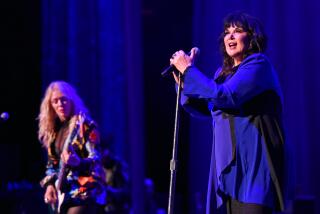From Dolley Madison to Harriet Tubman, students learn about women as role models and . . . : Unsung Heroes
- Share via
GLENDALE — It came as a surprise to some pupils in Bill Sanderl’s eighth-grade social studies class that for much of American history, women could not own property, speak in public, execute legal contracts or vote.
But last month, students at Glendale’s Toll Junior High School learned about how American women have struggled for equal rights through two centuries of democracy.
“You’ve already studied several important women,” Sanderl said to the class. He recalled Sacajawea, the young Shoshone woman who guided the expedition of Lewis and Clark through the Northwest Territory, and DolleyMadison, wife of the fourth U.S. President who risked death by remaining behind to rescue important Cabinet papers and a famous portrait of George Washington when British troops sacked Washington.
Then, it was time to meet some other significant women, starting with the authors of their social studies textbook, “A More Perfect Union.” Sanderl asked students to turn to the cover page and pointed out that two of the four authors are women.
“If we’re going to try to build a better United States, then all groups and minorities have to be objectively represented, and not just men,” Sanderl said.
Many students, especially the girls, said they found this a novel but confidence-boosting approach to learning history.
“It’s the first time that we’re learning men aren’t the ones who did everything in the past,” said Elizabeth Pimentel, 14, who, though not black, said she identified with Harriet Tubman, an escaped slave who led more than 300 other slaves to freedom through the Underground Railroad.
“She was a black woman, and usually they didn’t have any rights, but she did a lot for her people,” Pimentel added.
Sanderl discussed the contributions of a dozen American women, including Mercy Otis Warren, a patriot who wrote satirical plays about the British loyalists, and Dorothea Dix, a social reformer who worked to improve life for the mentally ill.
“All of these women are examples, not only for women but for people everywhere,” he said. “They went about righting something that wasn’t correct. They didn’t just sit back and moan and groan, they took action.”
The class also learned about the 19th Amendment, which gave women the right to vote in 1920. Sanderl noted that while the Declaration of Independence said all men were created equal, it didn’t say anything about women and slaves.
That began to change with the Seneca Falls Convention of 1848, when about 300 women gathered in New York to demand equality under the law. Men stood on the sidelines and jeered them.
Students watched a videotape of women throughout history that included a re-enactment of the conference. At the conference’s end, women wrote their own declaration of independence, inserting the word “women” in strategic places, such as: We hold these truths to be self-evident: that all men and women are created equal.”
Studying historic documents such as the Seneca Falls declaration fits into the new literature-based social studies framework adopted last fall by the Glendale Unified School District. The curriculum covers the historical contributions of men, as well as women and minorities--who have traditionally been underrepresented in textbooks.
Sanderl teaches his students about the difficulties of women’s lives during America’s early days. On one hand, he said, women were treated with respect and put on pedestals. On the other, they were told by society that they belonged in the kitchen and in the home.
In the video, students heard 17th-Century businessman Benjamin Rush admonish young women: “Don’t be offended when I add that from the day you marry, you must have no will of your own.”
Sanderl’s students learned that finishing schools taught young ladies proper manners and grooming instead of history and physics. One finishing school advertised: “We will make you a star in your husband’s crown.”
They learned that Nathaniel Hawthorne called women writers: “A damn pack of female scribblers.”
They heard a colonial song sung winsomely by a group of women in long skirts and bonnets, and titled “I Wish I Were a Single Girl Again.”
Lastly, they listened to a speech by the mid-19th-Century freed slave and abolitionist Sojourner Truth, who helped hundreds of other slaves escape. Truth even visited the White House.
She wrote: “I have borne 13 children and seen most all of them sold off into slavery. I can plow and eat like any man, and bear the lash as well, and ain’t I a woman? And when I cried out a mother’s grief, no one heard but Jesus, and ain’t I a woman?”
The following day, Sanderl put the issue in contemporary terms by asking students to look at gender equality today in their own school.
“I was concerned that this information talked about women 150 years ago, but they need to see how it still affects their lives today,” he said.
Students wrote to their principal, assessing whether boys and girls receive equal treatment at the school. Some 13- and 14-year-old girls said discrimination against women hasn’t disappeared completely in 1992.
“We can still improve some things,” wrote Matilda Kiaman in her letter to Toll Principal Martin Pilgreen. “I think we should have boy yell leaders and boy drill teams. For P.E., the teams should be co-ed.
“I’m sure no one would want to be rejected for something just because of their sex.”
More to Read
Sign up for Essential California
The most important California stories and recommendations in your inbox every morning.
You may occasionally receive promotional content from the Los Angeles Times.













